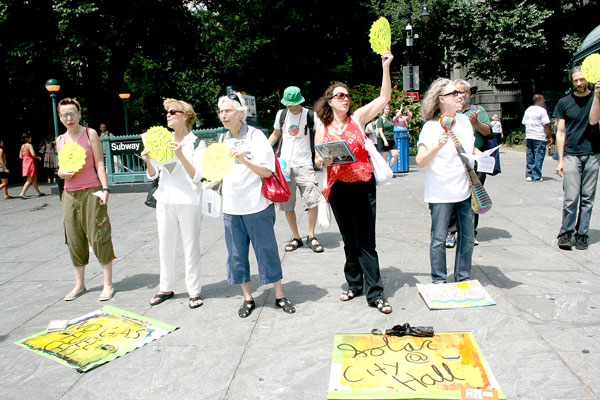
BY ALINE REYNOLDS | In an effort to curb greenhouse gas pollution, New York City buildings will be tapping into natural gas rather than dirty fossil fuels for their electricity supply, as advocated by Mayor Michael Bloomberg and other city and state officials.
The conversion plan is being met with opposition by a group of environmental activists, who claim the switch to natural gas will delay the widely accepted long-term goal of switching to solar, wind and other renewable forms of energy.
“We don’t believe that a transition period is necessary — in fact, it will undermine the conversion to other forms of energy,” said Lisa DiCaprio, a professor of social sciences at New York University, who joined the group of activists at an Aug. 4. demonstration dubbed “the Solar Party of City Hall.” It took place at the Centre Street entrance of City Hall Park.
Specifically, the group was rallying against the Mayor’s latest plan to install a $1.6 million natural gas fuel cell at City Hall by the end of 2011, rather than rooftop solar panels. The Mayor’s office initially proposed to install solar panels to power part of the three-story historic building in the spring of 2010, but nixed the plan earlier this year after discovering the system would be more costly and less energy-efficient than a natural gas-powered fuel cell.
The solar panels were never a truly viable option because, “[the panels] would have provided a minimal amount of electricity covering a small fraction of City Hall’s total usage,” according to Andrew Brent, a spokesperson for the Mayor.
The chemical reactions that take place in fuel cells to generate electricity do not involve any harmful emissions to the environment, according to Lawrence Gutterman, associate partner at Beyer Blinder Belle architects and planners. And the fuel cells are far more environmentally sustainable than if City Hall were kept on the grid.
But the activists are not convinced. Natural gas is still a fossil fuel, they say, and is responsible for 22 percent of greenhouse gas emissions in the U.S., according to a 2009 report published by the U.S. Energy Information Administration.
“If the Mayor decides to put fuel cells here, then it’s his way of converting the entire city to natural gas, and we’d be moving in a really horrible direction,” said Rezwana Zafar, an intern at Food & Water Watch, an organization that helped organize the Aug. 4 demonstration.
The fuel cell installation could further promote the use of hydraulic fracturing, or hydrofracking, a highly controversial drilling technique used to extract natural gas that has been proposed for implementation in upstate New York.
And, although natural gas fuel cells emit approximately 60 percent less carbon dioxide than do traditional combustion engines, the units are still fueled by a fossil fuel. According to DiCaprio, recent studies indicate that the overall carbon footprint associated with hydrofracking is comparable to that of oil or coal.
“The city and state are just looking at the greenhouse gas emissions at ther point of use. We want the decision to be made with regard to the environmental impact of the entire cycle, including production and transportation,” said DiCaprio.
The group is urging Bloomberg to revert to his original solar plan for City Hall, even if it means placing the panels on the periphery of City Hall Park. The city could raise funds for the project, the activists suggested, through the Office of Long-Term Planning and Sustainability.
“By placing solar panels [on or around City Hall], Mayor Bloomberg can signal his commitment to solar power in both a symbolic and real sense,” said DiCaprio.
The Mayor’s Office did not respond to requests for comments.
With respect to the cost, the future price tag of minimizing the negative effects of climate change is far greater than the cost difference between solar panels and fuel cells, according to DiCaprio.
“I think we have to look at cost effectiveness in the broader sense from the perspective of climate change,” DiCaprio said. “We don’t believe we can afford climate change, and that’s the framework in which we should look at energy policy—not the very specific cost comparison of this or that.”
Switching to natural gas, therefore, is “like putting a band-aid on a heart attack—it’s a terrible investment,” according to Joan Davis, a member of Gray Panthers, a nationwide education and advocacy organization.
At the Aug. 4 demonstration, the group chanted against the plan for fuel cells at City Hall and proceeded to put on a theatrical performance in which a narrator disparaged Bloomberg for not more firmly coming out against hydrofracking—particularly in the Marcellus Shale, a sedimentary rock formation that extends from western New York to West Virginia. The group is also protesting the New York-New Jersey Expansion Project, a pipeline expansion poised to transport natural gas to Manhattan. Bloomberg seems to endorse this initiative in his latest energy chapter of PlaNYC 2011, saying, “To ease supply constraints, we will assist developers in obtaining permits and approvals for appropriately sited natural gas transmission pipelines.”
Eighty percent of the world’s energy supply could be powered by renewable energy by 2050 if bolstered by adequate public policy, the group said, citing a recent report published by the Intergovernmental Panel on Climate Change. While the Bloomberg administration supports the expansion of solar, wind and hydropower, it also promotes natural gas as an alternative to oil and coal—in part by sponsoring an environmental campaign to close coal-fired power plants across the country. On the state level, the New York State Energy Research and Development Authority launched an initiative earlier this year, offering companies and institutions up to $1 million for natural gas fuel cell installations.
“There’s a lot of renewable energy that’s perfectly usable, and it’ll just get better and better,” said demonstrator Roxanne Perry, from Crown Heights, Brooklyn. “But if we keep investing in oil companies and gas companies, and piping, and roads… we’ll never have enough money to develop renewable energy.”
N.Y.S.E.R.D.A. is making strides in this effort, setting a goal to supply 30 percent of its electricity with renewable sources by 2015. A $4.6 million incentive program, for example, encourages institutions, as well as residential and commercial buildings, to install wind energy systems. N.Y.S.E.R.D.A. has also set aside $150 million until 2015 for solar photovoltaic systems.




































